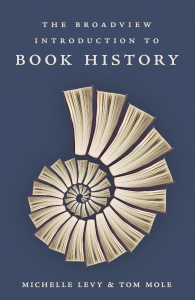
Co-authored with Michelle Levy (Simon Fraser University)
Buy from the publisher’s website.
Buy from Amazon.co.uk (affiliate link)
“This introduction to the still emerging and expanding field of book history is timely, welcome, and a delight to read. It is grounded in an appreciation of the myriad ways in which books can be studied and how they can illuminate important questions in literary, historical, and cultural studies. This lucid and nuanced overview of the discipline is the perfection introduction for students interested in the possibilities of book history and a welcome synthesis of new directions in scholarship including intermediality—oral and writing, manuscript and print—and the remediations accompanying developments in digital media and its textuality and reading practices.” —Margaret J.M. Ezell, Texas A&M University
“Remarkably concise, this substantive volume provides a very useful introduction to concepts and issues relevant to the study of the history of the book. No other text summarizes the multiple disciplinary contributions to this field across such a wide scope. The authors offer a useful overview of work in materiality, textuality, bibliography, production, and readership, as well as current debates on digitization and distant reading. One of the several unique dimensions of this book is the authors’ integration of media studies approaches into the study of books, print, manuscript, and electronic communications. The result is fresh and contemporary while respectfully inclusive of the scholarly traditions that have been vital to book history for more than a century. This will be exceptionally useful for introducing students and scholars at all levels to the overview of methods and topics in the field of book history. The book works as a stand-alone volume, but complements the work in the Broadview Reader on Book History assembled by the same authors.” —Johanna Drucker, University of California, Los Angeles
“This is a lucid and compendious introduction—suitable for undergraduates, graduate students, and more advanced scholars—to the production and dissemination of printed books, with a substantial concluding chapter on digital textuality and the co-existence of printed and digital books. A particular strength of BIHB is that it approaches its subject from multiple perspectives: historical, technological, and theoretical. Its purview not only extends across the ‘four epochs’ of the book—from the development of the manuscript codex to the arrival of the digital ‘media ecology’—but includes materials and techniques used in printing texts and images, the physical aspects of the book (essential information for bibliographical description), the evolution of reading practices, different schools of bibliographical and editorial theory (very useful in teaching students how to use scholarly editions critically), and the impact of digitization on publication and reading. Throughout the emphasis is on processes of mediation, reminding students that the relationship between writer and reader is always conditioned by technological, economic, and ideological factors, regardless of the textual medium.” —Nicholas Halmi, University of Oxford
What’s the book about?
Book history has emerged in the last twenty years as one of the most important new fields of interdisciplinary study. It has produced new interpretations of major historical events, has made possible new approaches to history, literature, media, and culture, and presents a distinctive historical perspective on current debates about the future of the book. The Broadview Introduction to Book History provides the most comprehensive and up-to-date introduction to this field. Written in a lively, accessible style, chapters on materiality, textuality, printing and reading, intermediality, and remediation guide readers through numerous key concepts, illustrated with examples from literary texts and historical documents produced across a wide historical range.
Who’s the book for?
It’s for anyone who wants to learn more about the history and future of books and reading. It’s aimed at people with no prior knowledge of the subject, and is ideal as a textbook for undergraduate and graduate classes in book history. You can read it alongside the Broadview Reader in Book History: the two books follow the same structure and are extensively cross-referenced. (If you buy them both at once, you can get a discount too!) It should also be useful for book historians, and people researching and teaching books, print, publishing, media and material culture.
How is it different from other introductions to book history?
What sets the Broadview Introduction to Book History apart is the range of approaches to the subject that it covers. We include a thorough introduction to textual scholarship and scholarly editing. We cover the basics of bibliography and typography. We investigate the history of reading. And we explore the connections between media – orality and writing, manuscript and print, e-books and paper books – to situate book history in relation to the latest developments in media theory. Finally, we look ahead and consider how our current moment of media change will affect how people produce, circulate, use, share and value books in the future. We have also included a chronology of book history, a guide to further reading, and a glossary of specialist terms.
Why publish this book now?
Book history is becoming more and more popular with undergraduates and graduate students, with more and more classes being taught in the subject, and more and more people wanting to know about it. This is partly because it offers a powerful set of intellectual tools for understanding the past. But it’s also because we’re living through a transformation in the media that shape our learning, work and leisure – one that historians of the future may well understand to be as important as the invention of moveable type. Book history provides a distinctive historical perspective on current shifts in the media ecology, and it can help us understand what’s happening.
One comment
Comments are closed.